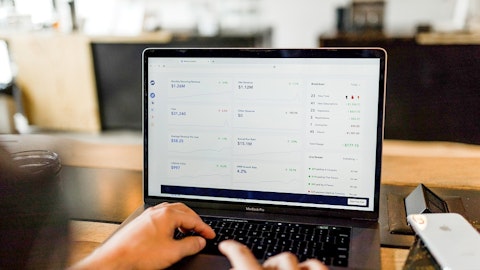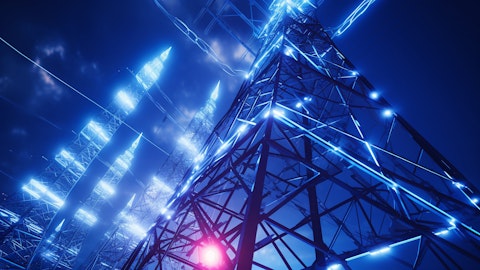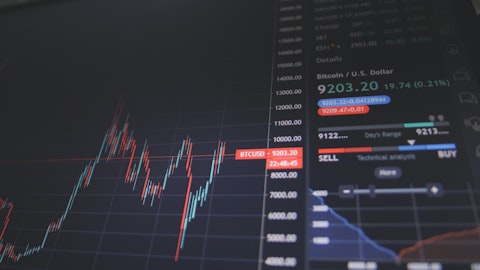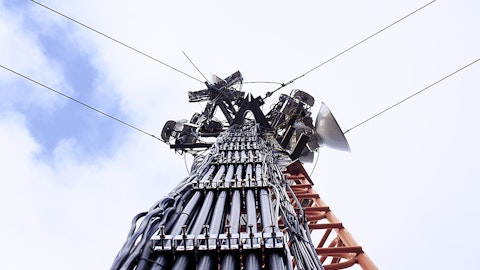Ilan Daskal: So as you know third fiscal quarter from a seasonality perspective is usually kind of slower than the second quarter. So if you think about it on a consecutive basis, then also when you have kind of the beginning of the calendar year, there’s some incremental cost associated with employee related and that kind of drives kind of in terms of the OpEx. But again, as Oleg mentioned earlier, the traditional seasonality, when you think about it, is kind of building up really nicely when you think about the rest of the year, including the fourth quarter.
Oleg Khaykin: So there’s a lot of statutory cost accrual that happens in the first quarter of the calendar year. And on the OSP, you notice there’s a lower margin because it’s cyclicality of a 3D sensing. The second half of a fiscal year is a much lower utilization, so there is more underabsorption in that respect. Now that said, the anti-counterfeiting is coming back, so it’s offset some of it but not all of it. And last quarter, the 3D sensing was quite strong.
Operator: Your next question comes from the line of Tim Savageaux from Northland Capital.
Tim Savageaux: Oleg, can you remind us of your lead times in service provider fiber test?
Oleg Khaykin: Generally, if we get an order, I’d say within two months, we can turn it around. So it’s all within a quarter, more or less. Now except for some things like, if it’s a — some products are very quick, like for example, fiber scope and things like that. Other products, like where you are buying a whole bench where you have MEMS, switches and things like that, if we have them in inventory, we can turn it around within, I’d say, two to three months.
Tim Savageaux: And where would you assess your service provider customer inventories to be with your product?
Oleg Khaykin: Zero. I mean, it’s all just in time.
Tim Savageaux: And I guess the reason I ask it is that throughout the early part of reports here from both some of your bigger peers, Corning, Nokia, as well as some of the bigger service providers, we have seen some early indications of project based kind of increases in plans for ‘24. And I’m just trying to reconcile what’s been a pretty consistent drum beat here with what we’re hearing from you. And I think there could be — typically, you lead these things. But I don’t know, might you lag at this point because of the lead times, I wonder? And are you seeing some of the same things?
Oleg Khaykin: No, I don’t think so. I don’t think we’re looking and once they decide. So when they tell these guys they’re going to do a project, they may tell it to them before they tell us, because once they’re ready to start building, they just place an order and within two months they get their equipment. It’s pretty quick.
Operator: Your next question comes from a line of Alex Henderson from Needham & Company.
Alex Henderson: Could you give us a little bit more granularity on the size of the 3D sensing in the quarter and the expectations for the 3D sensing in the March quarter?
Oleg Khaykin: So generally, Alex, 3D sensing, half of the annual demand comes in in the September and December quarter — two thirds comes in in the September and December quarter, and one third comes in the March and the June quarter. So I would say we ran right around $20 million, $25 million in the quarter.
Alex Henderson: And so in the upcoming quarter, you’re looking at what $10 million or so?
Oleg Khaykin: This quarter, I think maybe a little more than $10 million, but let me see. Yes, it’s about it — it is around — it’s $10 million plus minus $1.5 million.
Alex Henderson: And can you give us an update on the plant in Phoenix? It’s now fully operational. All of the benefits of the cost improvement are in the mechanics of the counterfeiting business at this point. Is that correct?
Oleg Khaykin: So what we are seeing now — so that’s when you know where people are running out of inventory. So you start seeing a lot of unforecasted spot orders popping up, like hurry up and ship as soon as you can. So we are starting to see more and more of these type of things popping up. They’re not big orders but it’s telling us the inventory is starting to deplete itself in the channel. So in the March quarter, we are expecting a little bit stronger demand from what we were thinking maybe even three months ago. So that’s actually helping us to offset some of the 3D sensing decline quarter-on-quarter.
Ilan Daskal: Generally, it’s fully operational and we still have more capacity for additional growth there. So it’s not in terms of full utilization, it’s not yet there in terms of the availability that we can get.
Alex Henderson: Fully operational but not fully — not full capacity…
Oleg Khaykin: Alex, let me give you a correction. Actually, 3D sensing is going to be closer about $16 million in this quarter. I was thinking the end of year.
Alex Henderson: So going back to this split on the 800 gig product, just to be clear. So the ratio of ports to equipment is quite low, right? I mean, we’re talking about double digit port per kind of ratio there. I assume that this is predominantly going into the production side of it. It’s not going into the field deployment. And you’re talking about how many products can go through a test and measurement process in any given period, but that’s a sampling process. So the ratio is very high relative to the total number of ports that go across that equipment, right?



